- You are here:
- Home »
- McTighe
Tag Archives for " McTighe "

Competitive Possession Rondo
By Tug McTighe –
Description:
Here is a rondo that is not only good for ball possession and playing quickly, but also incorporates a real competition to ensure that the players aren’t just going through the motions. It works for younger or older players and can be simplified for less skilled players or made more difficult for higher level players if needed.
Setup:
Create four 10×10 or 12×12 grids as shown. Set up 4v1 or 5v2 rondos in opposite corners of the big grid with Black attacking and Yellow defending in one, and Yellow attacking and Black defending in the other.
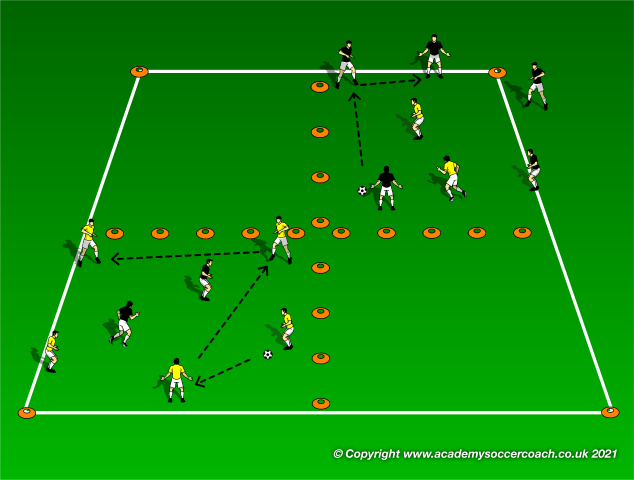
Execution:
Players in each rondo try to connect 4-6 passes (depending on skill level) without the defenders winning the ball. If defenders do win the ball, they quickly give the ball back to the attacking team and we start the connected pass count at 0 again.
NOTE: Defenders defend the whole time, they do not switch out upon winning the ball.
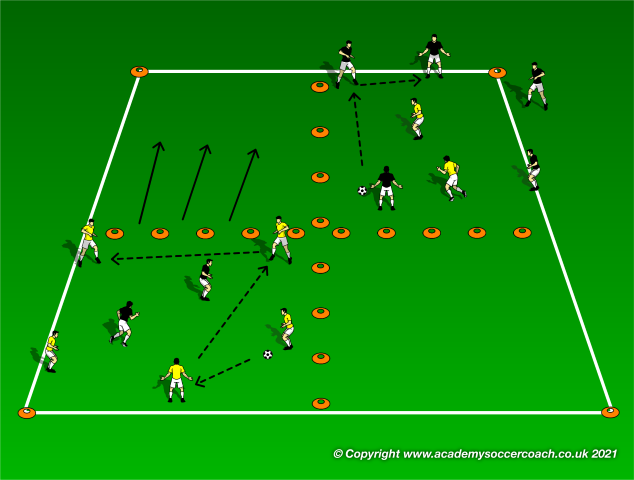
If either team connects the passes they need to connect, all players immediately move into the next grid in a clockwise rotation. They then continue the rondo, trying to connect the winning number of passes again.
The other rondo group stays where they are and tries to connect and move so they don’t get caught. This is the chasing part of the activity.
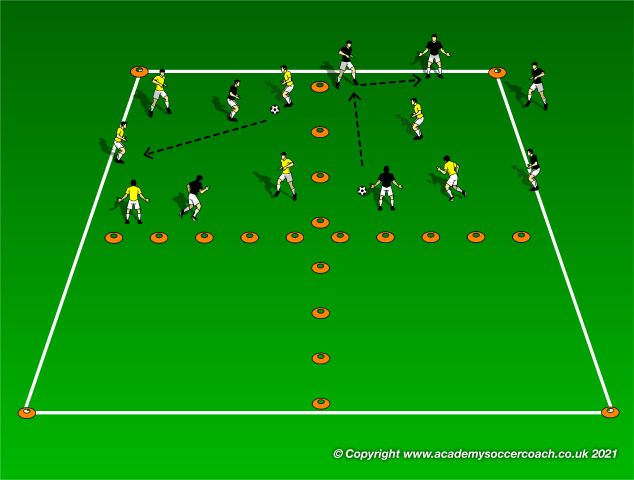
Each round is over when one group catches the other group. At this point we reset, switch player roles and start the next round.
Players can do “punishments” like burpees or push-ups to make the competition real. Keep score and play for a set number of rounds or to time.
By Tug McTighe
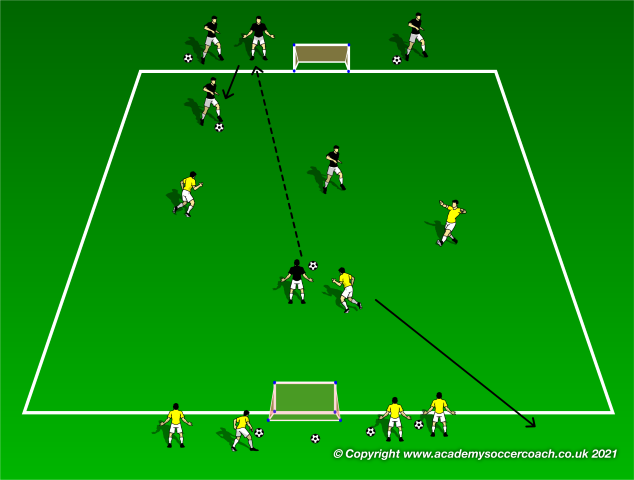
3v2 Bring Them In
By Tug McTighe –
Description:
The purpose of this activity is to help players create and take advantage of overloads. It also forces quick transitions from defending to attacking and back again by making the play continuous.
Setup:
30×20 grid with two small goals as shown. You can vary size and distance between goals per your team’s age and skill level. The smaller the space the more difficult it becomes for the players since they have less time and space.
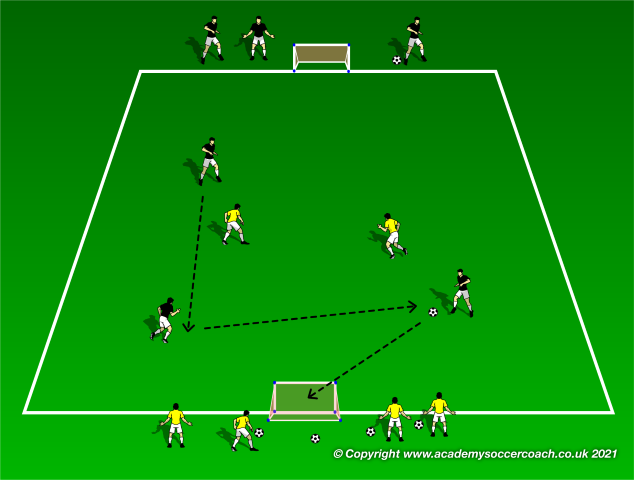
Execution:
3 black players attack 2 yellow players to start. They possess the ball and try to score.
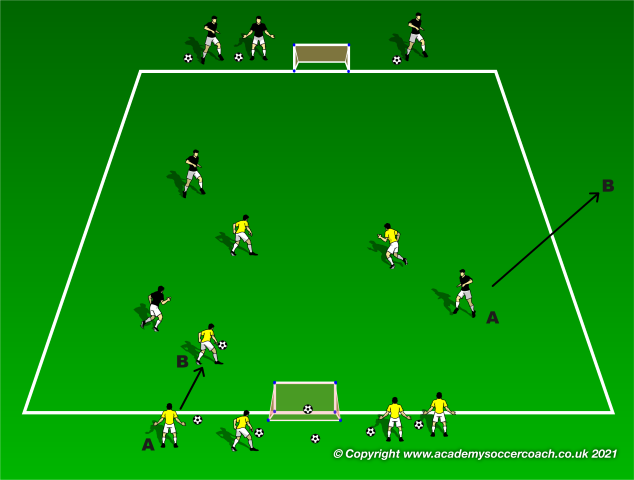
If black team does score, the player that scored immediately leaves the field (Black A to Black B) and a new yellow player comes on with a ball (Yellow A to Yellow B) to make it a 3v2 for yellow.

Yellow now tries to score. But if they are dispossessed, the player that lost the ball exits and the team that won possession must bring their new teammate on by passing the ball backward to one of the waiting players as shown above. They then play 3v2 as normal.
The same thing happens in other situations like a player shooting and missing or even losing the ball out of bounds – they exit quickly and the new player comes on for opposite team to keep the 3v2 going.
Coaching Points:
Find the overload and exploit the 2v1 situations.
Enter and leave the field quickly, the game should be continuous.
You must transition from attack to defense and back again quickly.
You should attack the opponent to create a give and go with your teammate or find the space in behind.
By Tug McTighe

Pass Receive Dribble
By Tug McTighe –
Description:
Since all coaches are strapped for time during training, here is an activity that is great for a practice or a game day warm up that incorporates passing and receiving as well as change of direction and 1v1 moves. All within a simple setup that doesn’t take up much space.
Setup:
Set up 3 passing cones as shown, as well as four cones or markers that will be used for the dribbling part of the activity. You can vary distance for age of players and ability level. 12-15 yards apart should work for most all age groups. The top of the triangle should be 20-25 yards. Depending on how many players you have, you could set up several of the triangles.
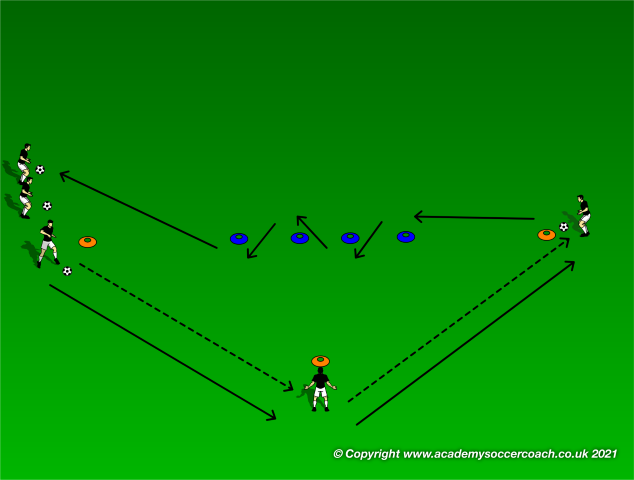
Execution:
Player 1 passes to Player 2. Player 2 passes to Player 3. Each player receives ball and passes to the next player. They then follow their pass to the next cone. Player 3 dribbles to the blue cones, slaloms through them, then dribbles to the end of the line.
Coaching Points:
Pass ball with proper technique and to their proper foot.
Receive ball across body with inside of foot and pass to next player, limiting touches.
Dribble through the cones quickly, but with proper technique, taking many small touches vs fewer large touches.
After a few minutes, make sure to start the ball at the opposite end to cover off on left foot passing/receiving as well.
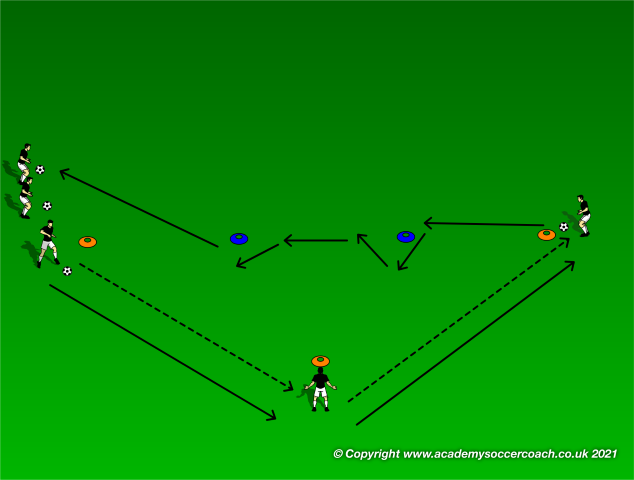
Progression 1:
Remove 2 of the blue cones as shown. Passing/receiving is same, but now the dribbling player does a 1v1 move to beat the first cone, and a 1v1 move to beat the 2nd cone. They then dribble to the end of the line as in previous diagram.
Moves: Scissor, double scissor, lean and push, chop, Maradona – really any move you want them to do.
Progression 2:
Now, rather than a 1v1 move, the dribbling player dribbles to the far cone, does a change of direction move, dribbles to the other cone, does a change of direction move there, and then dribbles to the end of the line.
Moves: Cruyff, outside/inside hook, pull back, pull v, Zico. Again, anything you have worked on.
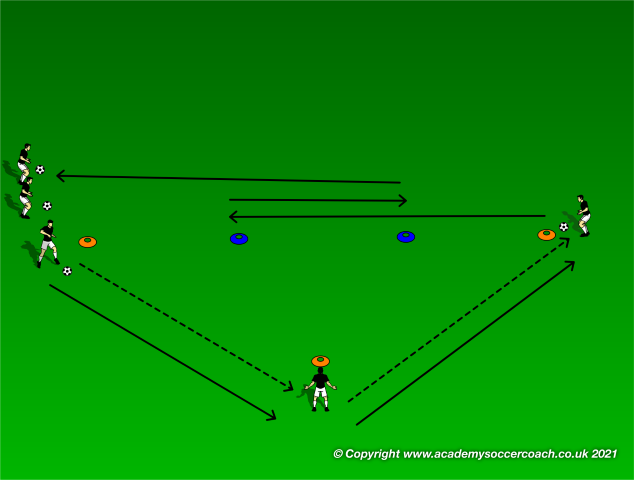
Make sure the activity progresses quickly by having all players ready with a ball, and don’t forget to cover off both left and right foot for passing and receiving every few minutes.
By Tug McTighe

1v1 Control and Compete
By Tug McTighe –
Description:
The purpose of this activity is to force both players to compete for the ball while playing 1v1. By forcing the attacking player to first control the ball, we are making it harder on him to be successful. At the same time, we are giving the defending players many opportunities to look for the visual cues as to when to try to win the ball. There are also many transitional opportunities for both players.
Setup:
15×15 grid with two small goals as shown. Vary size and distance between goals per your team’s age and skill level.
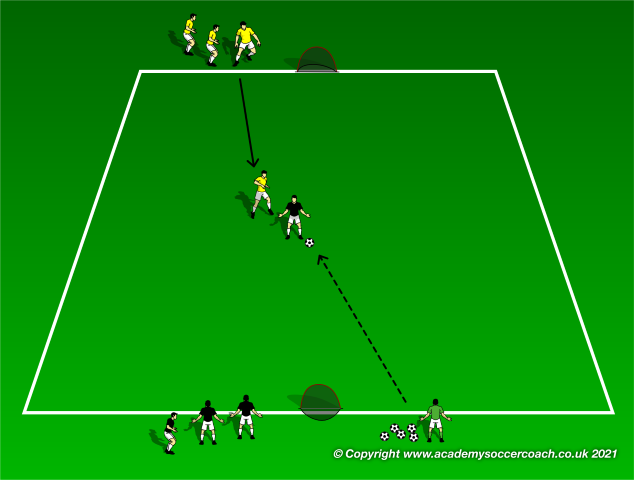
Execution:
Coach plays ball into attacker who tries to control it, turn and take on the defending player 1v1. If attacker scores, we start a new round. If defender wins the ball, they then attack the opposite goal. Play to goal, out of bounds, or to time.
Coaching Points:
Attacking player should check away and try to lose defender
Defending player should look for visual cues – bad touch, bouncing ball – to tackle.
Coach should vary services to make activity more game-like.
Really coach the competitive aspect of this activity for both players.
Variations:
Progression 1: Add a 2nd attacker as shown to play 2v1. Look for white attacker to control ball and bump back to teammate for combination play.
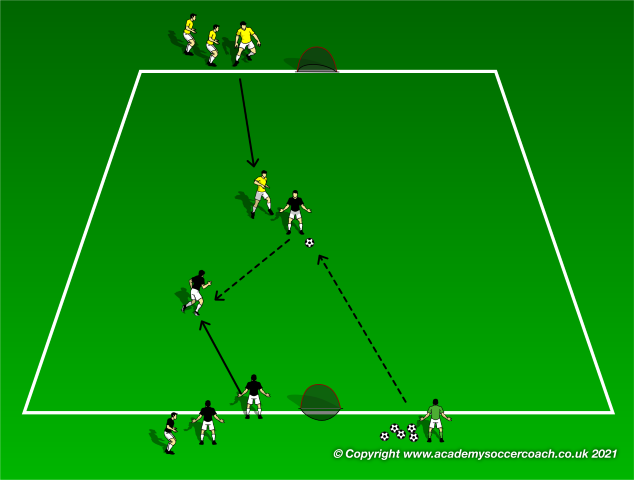
Progression 2:
Add 2nd defender to come in after the ball is controlled by white player to play 2v2.
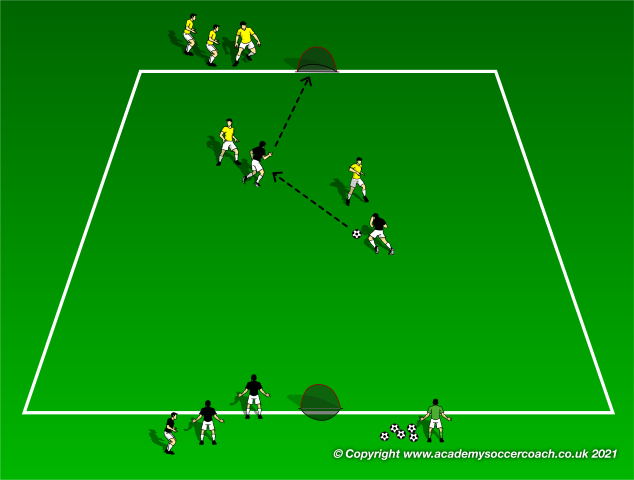
Play 3-4 minutes with one team attacking, then switch and let the other team attack. Keep score so there is always a winner.
By Tug McTighe
